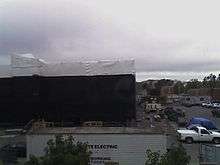Greyfield land
Greyfield land (or grayfield) is economically obsolescent, outdated, failing, moribund, or underused real estate assets or land. The term was coined in the early 2000s from the "sea" of empty asphalt concrete that often accompanies these sites. The word greyfield, also greyfields, is a relative neologism as compared to more commonly known terms such as brownfield and greenfield.

The term has historically been applied to formerly-viable retail and commercial shopping sites (such as regional malls and strip centers) that have suffered from lack of reinvestment and have been "outclassed" by larger, better-designed, better-anchored malls or shopping sites. These particular greyfield sites are also referred to as "dead malls" or "ghostboxes" if the anchor or other major tenants have vacated the premises leaving behind empty shells.[1]
Unlike brownfields, which feature actual or perceived levels of environmental contamination, greyfields typically do not require remediation in order to unlock value to an investor. The hidden value, in many cases, comes from underlying infrastructure (such as plumbing and sewerage, electrical systems, foundations, etc.) the presence of which allows a developer to improve the site efficiently through capital expenditures (sometimes quite minor) that may easily lead to increased rents and greater value. Other important potential qualities, such as parking, a central location, etc., may also be leveraged in a well-executed redevelopment of the site.
Some greyfields may also be considered favorable to investors because even if they are outclassed or physically in disrepair, they have revenue in place through long- or short-term leases. Greyfields with short-term leases may work well for an investor/developer who has a strategy involving intensive real estate asset management. By actively managing the greyfield in a short-term lease environment, rents may be increased after improvements are made.
The "greyfield" term may also be applied more broadly to urban infill or commercial locations where underuse or outdated (non-retail) uses hamper an otherwise valuable real estate asset. An example would be a formerly industrial waterfront site that is potentially valuable as a mixed use/residential site as it is being encroached upon by residential sprawl, or other economic or redevelopment pressures. In this example, the revitalization of the greyfield may require zoning changes and/or a public-private partnership of some kind to achieve the highest and best use.
Background
In 2001 the Congress for the New Urbanism coined the term "greyfield," which refers to aging strips of development that once served as vital commercial corridors during the post-World War II suburban exodus but have today fallen on harder times.[2] In contrast to contaminated brownfields and undeveloped greenfields, greyfields refer to "so-called 'dead malls,' often characterized by the vast empty asphalt parking lots that surround them."[3]
The most conservative calculations in 1999 estimated that there would be no fewer than 203 American greyfield malls with a combined outstanding debt of over $2 billion and projected redevelopment costs of over $11 billion by 2004. In 2001, of the 2,000 American regional malls, it was estimated that nearly 20% were greyfield malls or in danger of becoming one.[3]
Examples of greyfields in American cities are the Central City Mall in San Bernardino, California; the Prestonwood Town Center in Dallas, Texas; the Maple Hill Pavilion in Kalamazoo, Michigan; and the Lafayette Plaza in Bridgeport, Connecticut.[4]
Characteristics
An average site size of 45 acres (18 ha). These sites are both smaller and less connected to the regional transportation system than those housing America's best-performing malls, which average over 70 acres (28 ha) in size, with freeway visibility and direct ramp access.[3]
Located in established neighborhoods and shopping districts and on suburban arterials with bus service, many are already bus hubs.[3]
They have formidable competition; on average, greyfield malls have 2.3 million square feet (210,000 m2) million square feet of competing retail space in 22 other centers within 5 miles (8.0 km). They are often older and smaller than the most successful malls in their region.[3]
Conventional renovations will not be sufficient to breathe new life into many properties. A facelift will do little to help. A new anchor store, depending on the center's position in the market, may not do much either.[3]
Factors for redevelopment
Critical factors necessary for the redevelopment of a greyfield site include the following:[3]
- Market conditions.
- Ownership and anchor tenant status.
- Site and location factors.
- Municipal and community capacity.
- Developer and lender capacity.
Lessons from successful greyfield transformations are based on the case studies conducted by the Congress for New Urbanism. These sites were the Paseo Colorado development in Pasadena, California; the City Place development in Long Beach, California; the Belmar development in Lakewood, Colorado; the Downtown Park Forest development in Park Forest, Illinois; the Mizner Park development in Boca Raton, Florida; and the Winter Park Village development in Winter Park, Florida. The lessons learned in this study were:[3]
- Incorporate features that will maximize environmental benefits.
- Explore major physical changes.
- Use car parking carefully.
- Incorporate public amenities that add value and distinguish the development.
- Include civic and institutional activities.
- Expect a lengthy pre-development period and prepare for complications.
- Establish a high standard for urban design.
- Market the new concept.
- Develop mixed-uses that can thrive independently.
- Patient money is the best fit for town center projects.
References
- Moore, Robbie (26 February 2013). "The Death of the American Mall and the Rebirth of PublicSpace". The International. The International, Inc. Retrieved 4 December 2019.
- Gamble, Michael; LeBlanc, W. Jude (2004). "Incremental Urbanism: The Auto and Pedestrian Reconsidered in Greyfield Reclamation — Atlanta, Georgia" (PDF). Incremental Urbanism. 16 (3): 1.
- Congress for the New Urbanism. "Malls into Mainstreets: An In-Depth Guide to Transforming Dead Malls into Communities" (PDF). Congress for the New Urbanism. Archived from the original (PDF) on 7 July 2014. Retrieved 9 January 2014.
- Blackbird, Peter. "Dead Mall Stories". Deadmalls.com. Retrieved 4 December 2019.